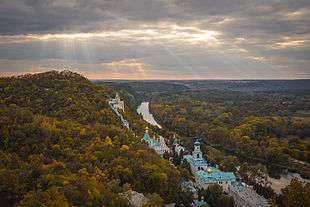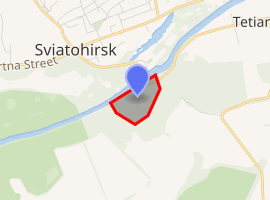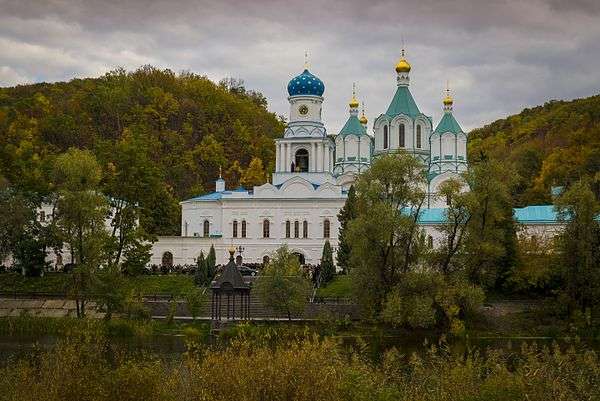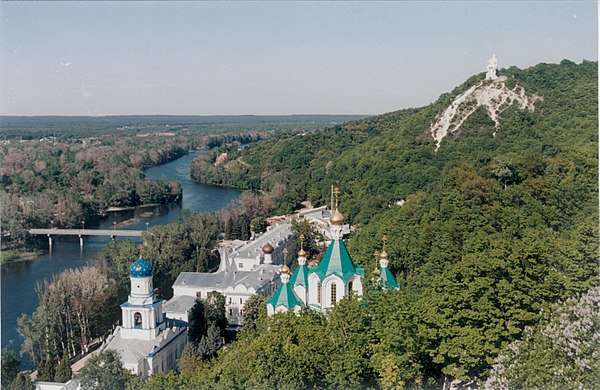Sviatohirsk Lavra
The Holy Mountains Lavra of the Holy Dormition (Ukrainian: Свято-Успенська Святогірська Лавра, Sviatohirsk Lavra or the Sviatohirsk Cave Monastery; Russian: Свято-Успенская Святогорская лавра, Sviatogorskaya Lavra or the Sviatogorsky Cave Monastery) is a major Orthodox Christian monastery on the steep right bank of the Seversky Donets River near the town of Sviatohirsk in Donetsk Oblast (province) of eastern Ukraine. The name comes from the surrounding Holy Mountains.
| Holy Mountains Lavra of the Holy Dormition | |
|---|---|
Свято-Успенська Святогірська лавра | |
 The Sviatohirsk Lavra from the left bank of the Seversky Donets River | |

| |
| General information | |
| Type | Lavra |
| Location | Donetsk Oblast |
| Country | |
| Opened | 1526 |
| Owner | Ukrainian Orthodox Church (Moscow Patriarchate) |
Today, the monastery forms the centrepiece of the Sviatohori National Nature Park. The Ukrainian Orthodox Church (Moscow Patriarchate) proclaimed it a lavra in 2004.
History
The first written mention of the monastery dates from 1627, although Sigismund von Herberstein had alluded to the "Holy Mountains" area as early as 1526. It is likely that the first monks settled the area in the 15th century. At the time it was a minor monastic establishment in the Wild Fields regularly ravaged by the Crimean Tatars.
In 1787, Catherine II had it shut down. The monastery's lands were secularized and donated to Prince Grigory Potemkin, the Viceroy of New Russia. One of his heirs, Aleksander Mikhailovich Potemkin, and his wife Tatiana, née Princess Galitzine, financed the monastery's revival and rebuilding, starting in 1844.
Before the October Revolution, the Sviatohirsk Monastery owned a worker's shop, windmills, various kinds of repair shops, and trading buildings. The lavra's main Dormition Cathedral was designed by Alexey Gornostaev, who included a traditional Byzantine tower. From 1917 onward, the Bolsheviks plundered and desecrated the monastery on numerous occasions, beating and killing many monks and in 1922, they shut the monastery down completely, setting up a Sanatorium for the Donbass workers on the grounds.[1]
Before World War I, the monastery was inhabited by approximately 600 monks. During the 1930s, some of the churches were demolished by the Soviets, along with other numerous religious attractions throughout the Soviet Union.
After the fall of the Soviet Union and the regaining of Ukrainian independence in 1991, the monastery was restored a year later. In 2004, the monastery was officially granted the status of a Ukrainian Orthodox Church lavra. Today, the monastery community consists of more than 100 monks, and is increasing each year.
On October 25, 2005, the National Bank of Ukraine issued its 10-hryvnia commemorative coin depicting the Sviatohirsk Lavra.[2]


References
- "Svyatogorsk Lavra :: "The Svyatogorsk Blessed Virgin", sculptor N. Shmatko :: Svyato-Uspenskaya Lavra". www.kingofmarble-shmatko.com. Retrieved 2020-07-11.
- "NBU releases the Sviatohirsk Lavra on the "chervonets"". ForUm (in Russian). Archived from the original on 2007-09-29. Retrieved 2007-04-27.
- Vlasenko, Petro. "Sviatogorsky Uspensky Monastyr 17th-19th centuries". Monuments of architecture of Ukrainian SSR (in Russian). p. 138. Retrieved 2007-04-26.
- "Sviato-Uspenska Sviatohirska Lavra". Ukrainian Orthodox Church (in Ukrainian). Retrieved 2007-04-26.